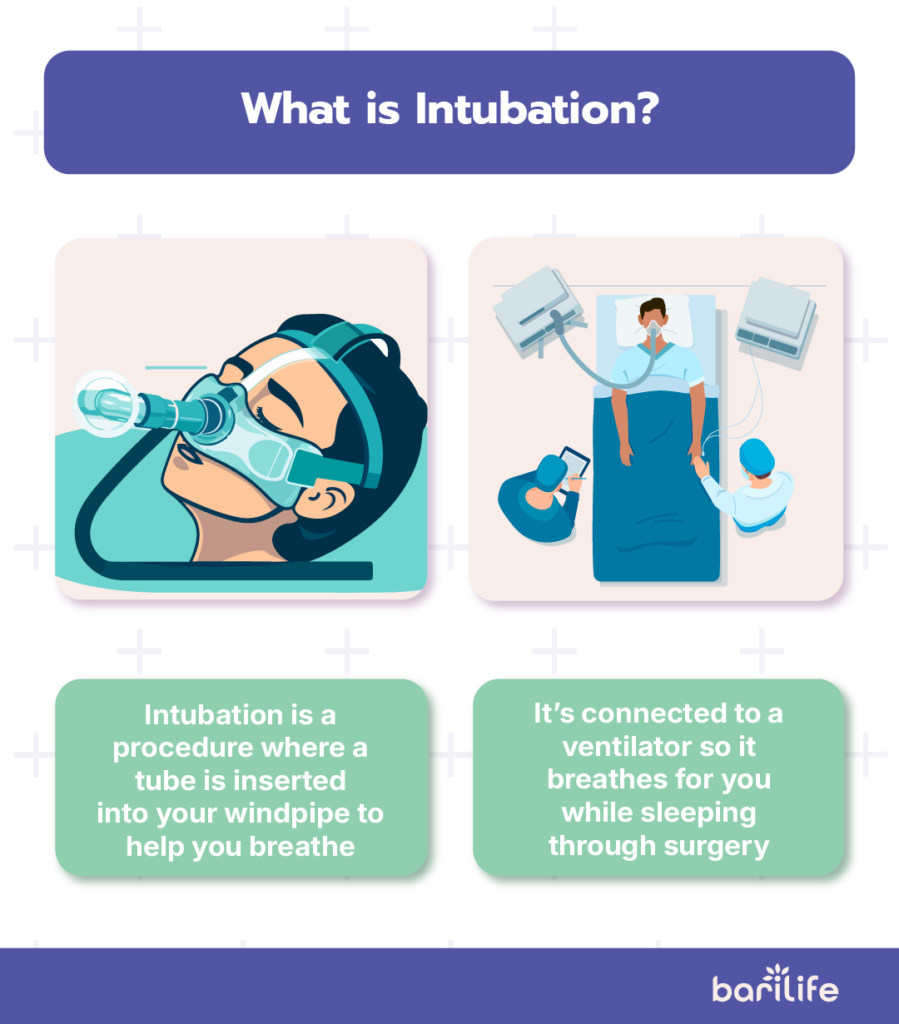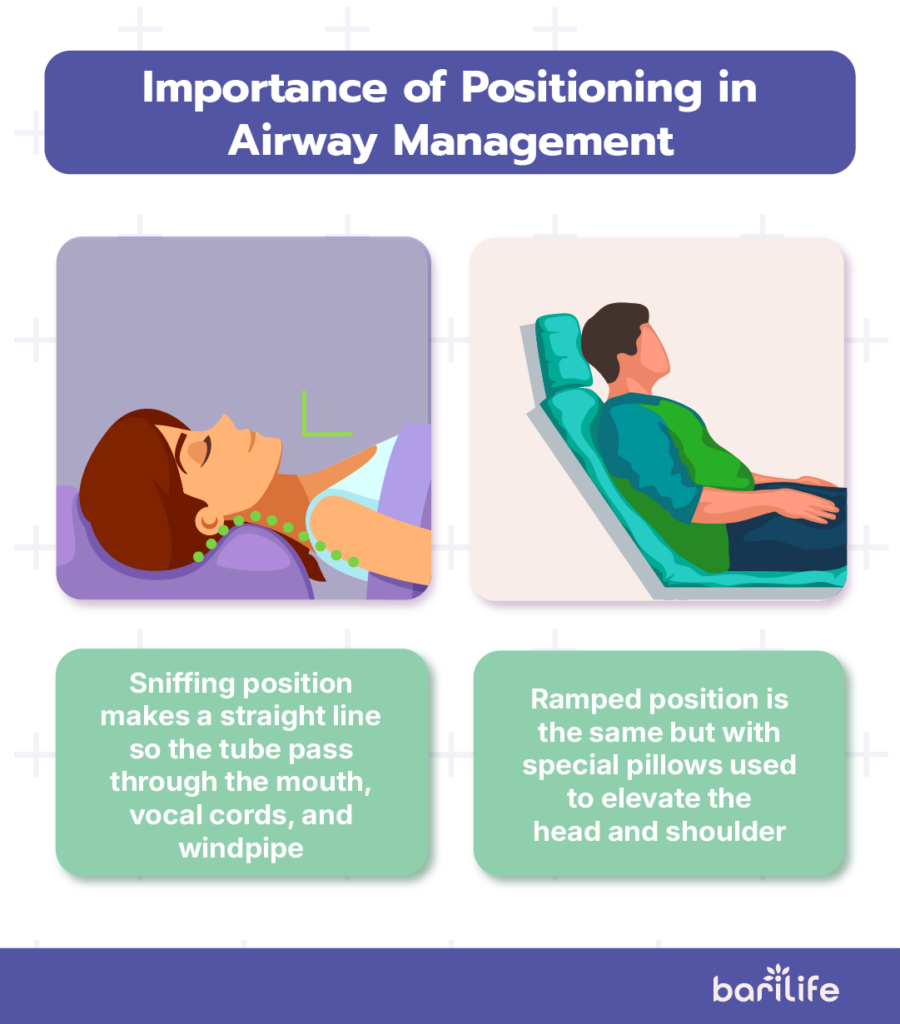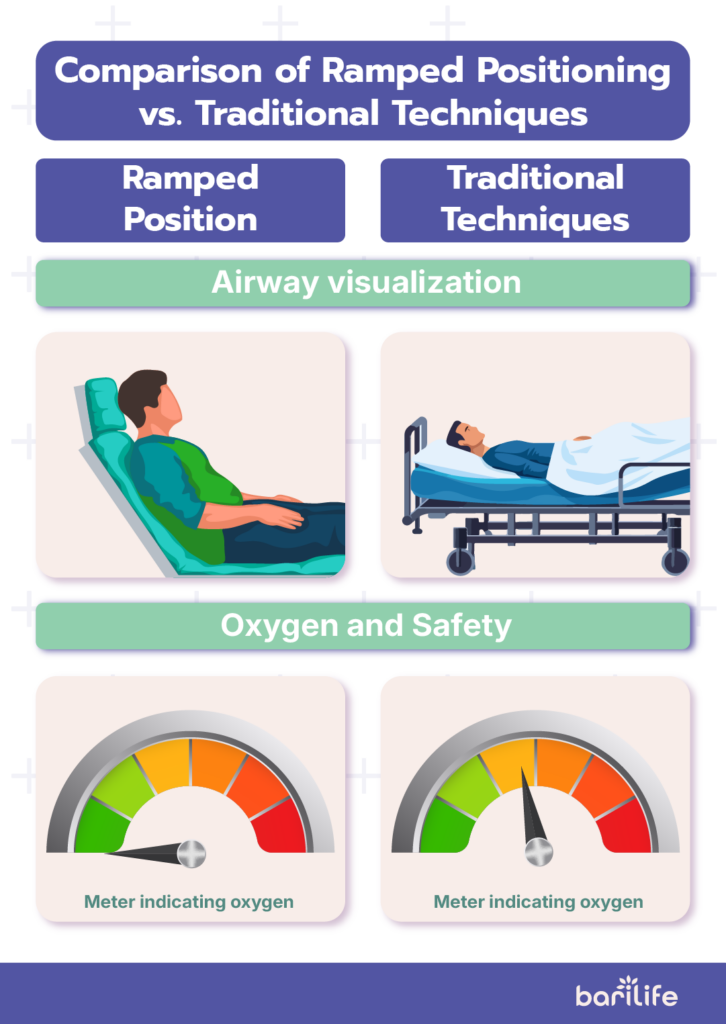Key Takeaways
- The ramped position is a unique method of elevating the head and shoulders for ease of intubation before bariatric surgery.
- It decreases the risk of complications and makes it easier for healthcare professionals to place the tube correctly.
- You may have slight throat or neck discomfort after intubation.
Managing your airway during bariatric surgery is crucial. Before surgery, a healthcare professional will place a tube down your throat that controls your breathing. This process is called intubation. (Don’t worry, you’ll be sleeping when they do this!)
However, excess body weight makes it difficult to intubate properly. To overcome these challenges, medical professionals have developed the ramped position, which involves elevating the head and shoulders with special pillows for easier intubation.
Read on to learn more about the challenges of intubating people with obesity, why positioning for airway management matters, the benefits of the ramped position, and more.
Table of Contents
What is Intubation?
Intubation is a medical procedure where a healthcare professional, such as a physician or anesthesiologist, inserts a flexible tube, called an endotracheal tube, through your mouth and vocal cords and into your windpipe. They may use a laryngoscope tool to help them see inside your throat better and guide the tube where it needs to be.

Once the tube is in place, it’s connected to a ventilator, which breathes for you while you sleep through surgery.
When the surgery is over, and before you fully wake up, the tube is removed, and you’ll naturally breathe on your own again.
Challenges of Intubation in Obese Patients
One challenge of intubating a person with obesity is the extra weight in the neck and chest area can reduce the health professional’s ability to see the vocal cords during intubation. This can cause complications in securing your airway.
Another challenge is the increased risk of hypoxia or not enough oxygen. When you breathe out, your lungs don’t completely deflate. The remaining air helps maintain oxygen levels in your blood. However, people with excess weight have less air remaining in their lungs, which can cause them to decrease their oxygen levels faster if the airway isn’t placed quickly.
Lastly, intubating a person with obesity often requires specialized equipment, such as video laryngoscopes (a camera that helps the healthcare professional visualize the airway). The person may also need additional training and expertise to overcome the previously discussed challenges.
Importance of Positioning in Airway Management
When a medical professional intubates a person, they place the person in the “sniffing position.” This means the person’s head is tilted slightly back so that the top of the chest bone is aligned with the ear’s opening, making a straight line for the airway to pass through the mouth, vocal cords, and windpipe.
The same sniffing position rules apply for the ramped position, but special pillows are also used to elevate the shoulders and head. This extra elevation helps move excess weight down and away from the neck area.
When following proper positioning, the healthcare provider can visualize the structures in the mouth and throat they need to see to place the intubation tube properly.

Proper positioning also reduces the risk of accidentally injuring airway structures or putting the intubation tube down the esophagus, leading to the stomach rather than the lungs. I’m sure you can imagine that pumping air into your stomach rather than your lungs is not very useful during surgery (it’s actually quite dangerous).
Lastly, another benefit of proper positioning, is the lungs can function more easily, particularly in people with obesity. This helps reduce the risk of low oxygenation, ensuring better recovery and promoting easier integration of post-surgery bariatric protein shakes into the patient’s diet for healing.
Benefits of Ramped Positioning
The ramped position has been shown to improve the ease and speed of intubation in people with obesity.
According to a study comparing intubation times in the ramped versus the sniffing position, patients in the ramped position had significantly shorter intubation times and easier ventilation.
This improvement is due to the airways being better aligned in the ramped position, which also made the airway wider and minimized difficulties caused by excess tissue in the neck and chest area.
The health professionals had a much easier view of the airway structures in the ramped position, which helped them insert the intubation tube quickly and easily.
The study also showed that the patients had better oxygenation during surgery when in the ramped position. This makes it easier for patients to absorb post-surgery nutrients such as bariatric vitamins and bariatric multivitamins with iron to support recovery.
For those undergoing bariatric revision surgery, the ramped position is especially beneficial in ensuring a smooth and safe intubation process.
Comparison of Ramped Positioning vs. Traditional Techniques
| Feature | Ramped Position | Traditional Techniques |
| Airway visualization | Better view of the airway opening makes intubation easier, which is especially helpful for patients with high BMI. | Can make it harder to see the airway opening, especially in patients with higher BMI. |
| Oxygen and Safety | Improves oxygenation by keeping airways open, reducing the chance of oxygen levels dropping, which is critical for maintaining overall wellness when using liquid bariatric vitamin post-surgery. | Less effective at keeping airways open, which may lead to faster oxygen loss during intubation. |
| Patient Comfort | Provides better comfort, especially for obese patients, and reduces complications like airway trauma or accidental placement in the esophagus.Comfortable recovery also encourages patients to start bariatric protein bars or bariatric snacks early for energy. | Lower comfort and potentially higher risk of complications during intubation, such as airway trauma or placement in the esophagus. |

What to Expect After Intubation
When you wake up from bariatric surgery, you won’t have the intubation tube in your airway anymore, but you may feel some discomfort caused by having the airway.
Some people have a sore throat or have trouble swallowing or talking. Your neck might also feel sore.
If you feel really uncomfortable, you can ask your doctor for a throat spray or lozenges to help ease the discomfort.
Conclusion
The ramped position used for intubation in bariatric surgery has several advantages for both patient safety and comfort.
This method aligns the airway, allowing healthcare professionals to visualize and intubate more easily, improving outcomes.
Additionally, the ramped position reduces the risk of complications and ensures better oxygenation, making it ideal for patients undergoing restrictive vs malabsorptive bariatric surgery techniques, and even those considering reversible bariatric surgery in the future.
If you want to learn more, why not check out these articles below:
- What is bariatric surgery?
- Bariatric surgery cost
- Bariatric surgery safe
- Bariatric Surgery vs Liposuction
- Robotic vs Laparoscopic Bariatric Surgery




What are your tips and tricks to post-bariatric success?